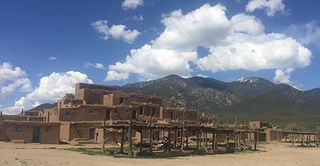The most critical questions of our time are related to social psychology.
This one tops the list: Is there any way that large groups of people can be convinced to stop acting in their immediate self-interest, and join together to save the future world for their children, and their children’s children?
It is easy to be pessimistic about that question. Forty years ago, I gave my final lecture to my social psychology class -- about global social problems -- and noted that the world population had zoomed up to well over 3 billion, doubling in just the short time since my mother was a child. At that time, scientists worried that it would double again by some time in the 21st century, unless we found a way to encourage people to slow down their reproductive rates.
Well, the population has in fact doubled since that time. And with all those billions of new people has come oceans full of plastic bags floating in increasingly polluted water, fish and bird species going extinct at geologically record rates, polar ice caps and million-year old glaciers melting like ice cream cones in August, cities like Delhi and Beijing where the air is unfit to breathe, and worst of all, increasing problems finding parking spots for our SUVs! Then just today, one of the leading candidates for the presidency of the United States vowed to “cancel the Paris climate agreement,” and rescind Environmental Protection Agency regulations that curb emissions from coal-fired power plants, among other anti-environmentalist policies. So maybe it’s time to just give up the hope of saving the environment, buy a gas mask, and go with the flow.
Is there any glimmer of hope left for our species, whose members were designed by evolution to seek immediate comfort and maximize their reproductive potential, with brains big enough to control and even dominate the forces of nature, but not quite big enough to comprehend how that all plays out at a global level, or how to quit while we’re ahead?
Self-sustaining communities: Then and now.
Yesterday, I went to visit the Taos Pueblo, and heard one of the native guides describe how his ancestors had lived in this idyllic spot for 1000 years, drinking water and catching trout from the Red Willow creek, which flows down from the snow-capped peaks in the Sangre de Cristo Mountains. Although the pueblo is still there, and the buildings are still populated by members of the tribe that came 1000 years ago, the modern world has brought thousands and thousands of tourists driving up in their gas-guzzling SUVs, carrying their modern digital cameras, paying $16 a pop to imagine a world in which people once lived in harmony with nature, even as they help destroy that world.

But wait, maybe it’s not too late! Maybe the future world can harness new technologies and live in harmony with nature once again. And maybe that can even happen without having to give up all the comforts of modern life. A few miles down the road from the Taos Pueblo, there is another, much less visited, but equally interesting, tourist destination. It is called Earthship, and although it felt a bit like science fiction, it is in fact real, and they say it is the world’s largest self-sufficient residential community. The houses there are artistic and creative architectural achievements, designed to collect water from rain and snow, and to harvest energy from the sun, and then combine them to grow crops, and keep the people inside comfortable and well-fed.

Each of these amazing houses was built with recycled materials. For example, the thermal walls, which help keep the inside temperatures near 70 degrees F in the cool of winter and the heat of summer, are constructed from old dirt-filled automobile tires, covered with adobe in the style of the old Pueblo natives. The inner walls are surrounded by greenhouses whose windows are angled to collect the low Southern sun in the winter, with a roofline that keeps out the high sun in the heat of summer. Even though it is a low-water desert environment, there is no need for public water lines here, because the roofs collect rain and melted snow, and direct it into massive underground tanks. From there it is used several times – first filtered to become drinking water, then used to water the vegetables and fruits growing in the greenhouses, and for flushing toilets. Finally, it is filtered through soil and waters the outdoor plants. There are also no electric bills, because every house has abundant solar collectors to run computers and refrigerators, and bath and cooking water is heated by the sun. On their website – earthship.com – you can find lots of valuable information, including building designs, descriptions of the various systems that run those homes, as well as classes and books if you are inclined to learn more.
The visionary behind this community is Mike Reynolds, an eccentric architect who became disillusioned with the constraints of classic architecture and city planning rules. An interesting documentary, titled Garbage Warrior, reports on the many obstacles he faced on the way to building self-sustaining houses. He initially lost his architecture license, and had his community shut down, because of violations of standard rules, like those about providing electric lines, plumbing, and drinking water for subdivisions.
Reynolds’ basic argument is a powerful one – rather than sticking with the classic approach, which wastes the world’s increasingly scarce resources, and punishing anyone who tries to think outside the box-shaped subdivision house, we should be encouraging experimentation. What Reynolds and his associates have demonstrated is that it is possible to build houses out of recycled materials, and to build them so they require no external sources of electricity and water, and can even allow residents to grow enough food to feed themselves. The film ends on a note of optimism, reporting that Reynolds was eventually able to get the conservative New Mexico legislature to change its laws so that experimental approaches to sustainable architecture could move forward without restrictions that previously made innovation impossible.
Of course, the other part of the equation is controlling overpopulation. But there are glimmers of hope there as well. Although the world population continues to grow, the rate of growth in most parts of the world has slowed.
Now of course, the next step is getting people to change their behaviors and their choices. And that’s where social psychology and the other behavioral sciences can contribute to saving the world. If our brains were big enough to get us into this mess, maybe they can get us out.
Douglas Kenrick is author of The Rational Animal: How evolution made us smarter than we think and Sex, Murder, and the Meaning of Life: A psychologist investigates how evolution, cognition, and complexity are revolutionizing our view of human nature.
(Thanks to my wife, Carol Luce, who dragged me along to visit Earthship, took the photos I used here, and who cares deeply about saving the world for our son).




